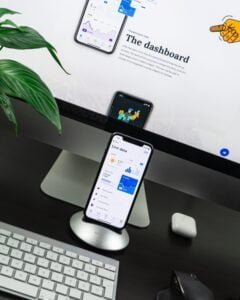Introduction
Welcome to the App Entrepreneur Journey
Embark on an exciting journey into the world of mobile app development and entrepreneurship. Whether you’re a seasoned developer or a novice entrepreneur, this guide will equip you with the knowledge and tools to create and monetize your own mobile app in 2024.
Why Mobile Apps Matter in 2024
In today’s digital age, mobile apps have become indispensable tools for businesses and individuals alike. With the proliferation of smartphones and tablets, consumers rely heavily on apps for communication, entertainment, productivity, and more. As technology continues to evolve, the demand for innovative and user-friendly mobile apps is only expected to grow.
Setting the Stage: Understanding the App Market Landscape
Before diving into the app development process, it’s crucial to understand the dynamics of the app market landscape. This includes analyzing industry trends, identifying competitors, and pinpointing opportunities for growth. By gaining a comprehensive understanding of the market, you can better position your app for success.

Getting Started: Ideation and Planning
Finding Your App Idea: Uncovering Your Passion Points
The first step in creating a successful mobile app is finding the right idea. Start by identifying your passion points and areas of expertise. Whether it’s solving a common problem or fulfilling a specific need, your app idea should resonate with your interests and align with market demand.
Researching the Market: Identifying Trends and Gaps
Once you have a solid app idea, conduct thorough market research to validate its viability. Look for existing apps in your niche and analyze their features, user reviews, and monetization strategies. Identify trends and gaps in the market that your app can capitalize on.
Defining Your Target Audience: Who Will Use Your App?
Understanding your target audience is essential for creating a successful app. Define the demographics, preferences, and pain points of your ideal users. This will help you tailor your app’s features and marketing strategies to meet their needs effectively.
Crafting Your Unique Value Proposition: What Sets Your App Apart?
With countless apps vying for users’ attention, it’s essential to differentiate your app from the competition. Define your unique value proposition – what makes your app stand out? Whether it’s innovative features, superior user experience, or niche targeting, highlight what sets your app apart from the rest.
Creating a Solid Business Plan: Mapping Out Your App’s Success
A well-thought-out business plan is the roadmap to success for your app. Outline your goals, target market, revenue streams, and marketing strategies. A comprehensive business plan will not only guide you through the development process but also attract investors and stakeholders.
Development Phase: Bringing Your App to Life
Choosing the Right Development Platform: Native vs. Hybrid
One of the first decisions you’ll need to make is choosing the right development platform for your app. Consider factors such as performance, scalability, and cost when deciding between native and hybrid development approaches.
Finding the Right Development Team: In-House vs. Outsourcing
Whether you choose to build your app in-house or outsource development to a third-party agency, assembling the right team is crucial. Look for experienced developers, designers, and project managers who can bring your vision to life within your budget and timeline.
Designing Your App’s User Experience (UX): Making It Intuitive and Appealing
User experience (UX) plays a significant role in the success of your app. Design an intuitive and visually appealing interface that enhances usability and keeps users engaged. Conduct usability testing to gather feedback and iterate on your design until it meets users’ needs.
Developing Your App’s User Interface (UI): Creating a Stunning Design
In addition to UX, the user interface (UI) design is equally important for creating a memorable app experience. Pay attention to typography, color schemes, and visual elements that align with your brand identity and appeal to your target audience.
Coding Your App: Building the Backbone of Your Project
With the design in place, it’s time to start coding your app. Whether you’re proficient in programming languages like Swift, Kotlin, or React Native, or rely on development frameworks and tools, focus on writing clean, efficient code that powers your app’s functionality.
Testing and Refinement
Conducting Beta Testing: Getting Feedback from Early Users
Before launching your app to the masses, conduct beta testing with a select group of early users. Gather feedback on usability, performance, and bugs, and use this information to make necessary improvements before the official launch.
Iterating Based on Feedback: Refining Your App’s Features
Feedback from beta testing is invaluable for refining your app’s features and user experience. Be open to constructive criticism and iterate on your app based on user feedback to ensure it meets users’ expectations and addresses their pain points effectively.
Ensuring Compatibility: Testing Across Different Devices and Operating Systems
With a diverse range of devices and operating systems in the market, it’s essential to test your app for compatibility across various platforms. Conduct thorough testing on different devices, screen sizes, and operating system versions to ensure a seamless user experience for all users.
Polishing Your App: Squashing Bugs and Improving Performance
In the final stages of development, focus on polishing your app and ironing out any remaining bugs or performance issues. Use debugging tools and performance monitoring metrics to identify and resolve issues promptly, ensuring a smooth and reliable app experience for users.

Launch Strategies: Making a Splash in the App Store
Choosing the Right App Store(s) for Your Launch
Deciding where to launch your app is a critical decision that can impact its visibility and reach. Consider factors such as market demographics, competition, and platform requirements when choosing between the Apple App Store, Google Play Store, or other app distribution platforms.
Optimizing Your App Store Listing: Crafting Compelling Descriptions and Graphics
Your app store listing is the first impression users will have of your app, so make it count. Craft compelling descriptions, titles, and visuals that highlight your app’s key features and benefits. Use keywords strategically to improve your app’s discoverability in search results.
Building Hype: Generating Buzz Before Your Launch
Generate excitement and anticipation for your app by building hype leading up to the launch. Tease sneak peeks of features, run pre-launch marketing campaigns, and engage with your audience on social media to create buzz and drive downloads on launch day.
Leveraging Influencers and Partnerships: Amplifying Your Reach
Collaborate with influencers, bloggers, and industry partners to amplify your app’s reach and visibility. Partnering with influencers who resonate with your target audience can help generate buzz and credibility for your app, driving downloads and user engagement.
Timing Your Launch: Finding the Perfect Moment for Maximum Impact
Timing is everything when it comes to launching your app. Consider factors such as market trends, seasonality, and competitor activity when choosing the optimal launch date. Aim to launch your app at a time when demand is high and competition is low for maximum impact.
Monetization Methods: Turning Your App into a Profitable Venture
Exploring Different Monetization Models: Freemium, In-App Purchases, Subscriptions, and Ads
There are various monetization models to choose from when monetizing your app. Explore options such as freemium, where the app is free to download but offers premium features for a fee, in-app purchases, subscriptions, and advertising to determine the best fit for your app and target audience.
Choosing the Right Pricing
Strategy: Finding the Balance Between Value and Revenue. Finding the right pricing strategy is crucial for maximizing revenue while providing value to your users. Consider factors such as app features, competition, and user willingness to pay when determining your app’s pricing strategy. Test different pricing tiers and adjust as needed based on user feedback and market demand.
Implementing In-App Advertising: Maximizing Ad Revenue Without Compromising User Experience
In-app advertising can be a lucrative revenue stream for your app, but it’s essential to strike the right balance between monetization and user experience. Implement non-intrusive ad formats, such as native ads or rewarded videos, that seamlessly integrate with your app’s content and provide value to users.
Offering Premium Features: Convincing Users to Upgrade to Paid Versions
Offering premium features or content upgrades is another effective way to monetize your app. Identify features that offer significant value to users and incentivize them to upgrade to a paid version or subscription plan. Highlight the benefits of premium features and offer free trials or discounts to encourage conversions.
Diversifying Revenue Streams: Exploring Sponsorships, Merchandising, and Partnerships
Diversify your app’s revenue streams by exploring opportunities for sponsorships, merchandising, and partnerships. Collaborate with brands, retailers, or other businesses to offer sponsored content, in-app purchases, or exclusive promotions that enhance the user experience and generate additional revenue.

User Acquisition and Retention Strategies
Implementing App Store Optimization (ASO): Increasing Visibility and Downloads
App Store Optimization (ASO) is essential for improving your app’s visibility and driving organic downloads. Optimize your app store listing with relevant keywords, compelling visuals, and positive reviews to increase visibility and attract more users to download your app.
Leveraging Social Media Marketing: Engaging with Your Audience and Building a Community
Social media marketing is a powerful tool for engaging with your audience, building brand awareness, and driving app downloads. Create compelling content, run targeted advertising campaigns, and engage with your audience on platforms like Facebook, Instagram, and Twitter to build a loyal following and drive user acquisition.
Running User Acquisition Campaigns: Targeting the Right Audience with Paid Ads
Paid advertising campaigns can help you reach a broader audience and drive app installs quickly. Identify your target audience, set clear campaign objectives, and leverage advertising platforms like Google Ads, Facebook Ads, or Apple Search Ads to target users based on demographics, interests, and behaviors.
Fostering User Engagement: Keeping Users Hooked with Regular Updates and New Features
User engagement is critical for retaining users and driving long-term success for your app. Keep users engaged with regular updates, new features, and content that add value and improve the overall app experience. Encourage user feedback and incorporate user suggestions to keep your app relevant and engaging.
Implementing Retention Strategies: Encouraging Repeat Usage and Loyalty
Retaining users is just as important as acquiring new ones. Implement retention strategies such as personalized notifications, loyalty programs, and exclusive content to keep users coming back to your app. Build strong relationships with your users and reward them for their loyalty to increase retention and lifetime value.
Measuring Success: Tracking Metrics and KPIs
Identifying Key Performance Indicators (KPIs): What Metrics Matter Most?
Tracking key performance indicators (KPIs) is essential for measuring the success of your app and identifying areas for improvement. Identify KPIs such as downloads, active users, retention rate, and revenue to gauge the performance of your app and make data-driven decisions to optimize its success.
Analyzing User Behavior: Understanding How Users Interact with Your App
Understanding user behavior is crucial for optimizing your app’s user experience and driving engagement. Analyze metrics such as session duration, screen views, and in-app actions to gain insights into how users interact with your app. Use this data to identify usability issues, optimize features, and improve overall user satisfaction.
Monitoring Revenue Streams: Tracking Revenue and Profitability
Monitoring your app’s revenue streams is essential for understanding its financial performance and profitability. Track metrics such as average revenue per user (ARPU), customer lifetime value (CLV), and return on investment (ROI) to assess the effectiveness of your monetization strategies and make informed decisions to maximize revenue.
Gathering User Feedback: Listening to Your Audience for Continuous Improvement
User feedback is invaluable for identifying areas for improvement and driving ongoing innovation for your app. Collect feedback through app reviews, surveys, and in-app feedback forms, and use this information to identify pain points, prioritize feature requests, and address user concerns to continuously improve your app.

Scaling Your App Business: Growing Beyond the Initial Launch
Expanding Your App’s Features: Adding Value for Existing Users and Attracting New Ones
Continuously evolve and expand your app’s features to keep users engaged and attract new ones. Monitor user feedback, market trends, and competitor activity to identify opportunities for new features and enhancements that add value and improve the overall app experience.
Scaling Your Infrastructure: Ensuring Your App Can Handle Increased Traffic and Usage
As your app grows in popularity, it’s essential to scale your infrastructure to ensure optimal performance and reliability. Invest in scalable server architecture, content delivery networks (CDNs), and cloud-based services to handle increased traffic, usage, and data storage requirements effectively.
Exploring New Markets: Expanding Your Reach Internationally
Expand your app’s reach and tap into new markets by exploring international expansion opportunities. Localize your app’s content, language, and marketing strategies to resonate with global audiences and adapt to cultural nuances and preferences in different regions.
Building a Brand Ecosystem: Creating Synergy Between Multiple Apps and Products
Create synergy between multiple apps and products within your brand ecosystem to maximize user engagement and revenue potential. Cross-promote your apps, offer bundled packages, and integrate complementary products and services to create a cohesive brand experience and foster user loyalty.
Frequently Asked Questions (FAQs)
Q: How much does it cost to create a mobile app in 2024?
A: The cost of creating a mobile app can vary significantly depending on factors such as complexity, features, design, and development platform. While simple apps can be developed for a few thousand dollars, more complex apps with advanced features may require investments ranging from tens of thousands to hundreds of thousands of dollars.
Q: Do I need to have coding skills to create a mobile app?
A: While having coding skills can be advantageous, it’s not always necessary to create a mobile app. There are various app development platforms, tools, and services available that allow individuals with little to no coding experience to create fully functional apps. However, having a basic understanding of programming concepts can be beneficial for customizing and troubleshooting your app.
Q: How long does it take to develop a mobile app?
A: The time it takes to develop a mobile app depends on various factors, including complexity, features, design, development platform, and team size. Simple apps with basic features may be developed in a matter of weeks, while more complex apps with advanced functionality may take several months or even years to complete. It’s essential to plan and budget for an appropriate timeline based on your app’s specific requirements.
Q: What are the most popular monetization methods for mobile apps?
A: Some of the most popular monetization methods for mobile apps include:
- Freemium: Offering a free version of the app with limited features and premium upgrades available for purchase.
- In-App Purchases: Selling virtual goods, premium content, or additional features within the app.
- Subscriptions: Offering recurring subscriptions for access to premium content, services, or features.
- Advertising: Displaying ads within the app and generating revenue through clicks, impressions, or interactions.
- Sponsorships and Partnerships: Collaborating with brands, advertisers, or other businesses to promote sponsored content or partnerships within the app.
Q: How can I market my mobile app effectively?
A: Marketing your mobile app effectively requires a comprehensive strategy that encompasses various channels and tactics. Some effective marketing strategies for promoting your app include:
- App Store Optimization (ASO): Optimizing your app store listing with relevant keywords, compelling visuals, and positive reviews to improve visibility and downloads.
- Social Media Marketing: Engaging with your audience on platforms like Facebook, Instagram, and Twitter to build awareness, drive downloads, and foster a community around your app.
- Paid Advertising: Running targeted advertising campaigns on platforms like Google Ads, Facebook Ads, or Apple Search Ads to reach your target audience and drive app installs.
- Influencer Marketing: Collaborating with influencers, bloggers, or industry experts to endorse and promote your app to their followers.
- Public Relations (PR): Generating buzz and media coverage through press releases, interviews, and media outreach to increase awareness and credibility for your app.
Q: How do I measure the success of my mobile app?
A: Measuring the success of your mobile app involves tracking key performance indicators (KPIs) and metrics that reflect its performance, engagement, and revenue. Some common KPIs to monitor include:
- Downloads: The total number of app installations from app stores.
- Active Users: The number of users who actively engage with your app within a specific time period.
- Retention Rate: The percentage of users who continue to use your app over time.
- Revenue: The total income generated from app sales, in-app purchases, subscriptions, or advertising.
- User Engagement: Metrics such as session duration, screen views, and in-app actions that indicate user interaction and engagement.
- Customer Satisfaction: Feedback and ratings from users, as well as reviews and testimonials, that reflect user satisfaction and sentiment towards your app.
Conclusion
Congratulations, You’ve Launched Your Own Mobile App!
You’ve reached the end of your app entrepreneur journey – congratulations! By following the steps outlined in this guide, you’ve successfully created and monetized your own mobile app in 2024. But remember, the journey doesn’t end here – continue to evolve, innovate, and adapt to stay ahead in the ever-changing app market landscape.
Recap of Key Takeaways
- Finding the right app idea that resonates with your passion points and market demand is crucial for success.
- Building a solid business plan, assembling the right development team, and prioritizing user experience are essential steps in the app development process.
- Implementing effective monetization, user acquisition, and retention strategies are key to turning your app into a profitable venture.
- Tracking metrics, gathering user feedback, and iterating based on insights are critical for continuous improvement and long-term success.
- Scaling your app business requires ongoing innovation, expansion into new markets, and creating synergy between multiple apps and products.
The Journey Doesn’t End Here: Continuing to Evolve and Innovate
As you embark on your app entrepreneur journey, remember that success is not a destination but a continuous journey of evolution and innovation. Stay curious, stay agile, and never stop learning and growing as an app entrepreneur in the dynamic and ever-changing landscape of mobile technology.
